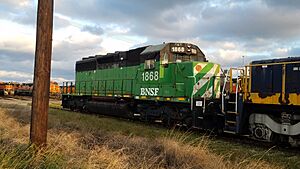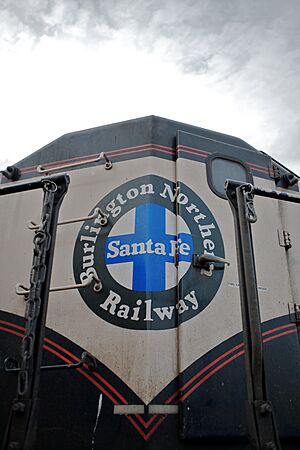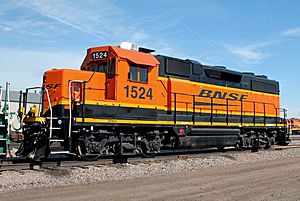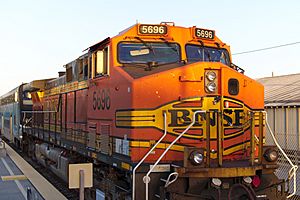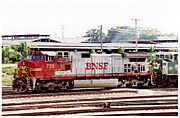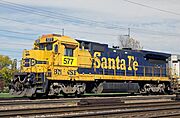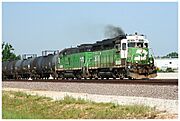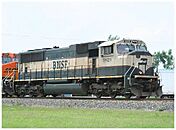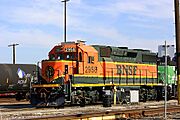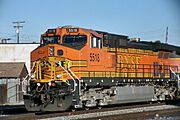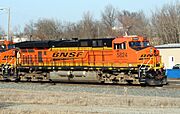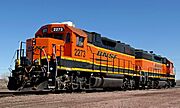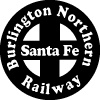BNSF Railway facts for kids
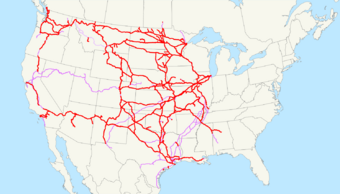
System map (trackage rights and former Montana Rail Link tracks in purple)
|
|
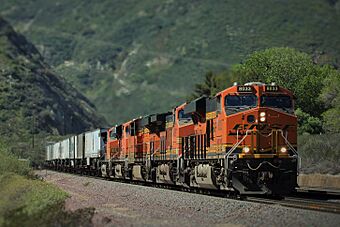
BNSF 8033 leads a freight train up California's Cajon Pass
|
|
| Overview | |
|---|---|
| Parent company | Berkshire Hathaway |
| Headquarters | Fort Worth, Texas |
| Reporting mark | BNSF |
| Locale | Western, Midwestern and Southern United States, Western Canada |
| Dates of operation | September 22, 1995–present |
| Predecessor | Atchison, Topeka and Santa Fe Railway Burlington Northern Railroad |
| Technical | |
| Track gauge | 4 ft 8 1⁄2 in (1,435 mm) standard gauge |
| Length | 33,400 miles (53,800 km) |
BNSF Railway is the biggest freight railroad in the United States. It is one of the six largest railroads in North America. BNSF has 36,000 employees and operates over 33,400 miles of track in 28 states. It also has more than 8,000 locomotives.
BNSF has three main routes that cross the entire country. These routes connect the western and eastern parts of the United States. In 2010, BNSF trains traveled over 169 million miles, which was more than any other railroad in North America.
The company's main office is in Fort Worth, Texas. BNSF Railway is owned by Berkshire Hathaway Inc., a large company based in Omaha, Nebraska. The current CEO of BNSF is Kathryn Farmer.
BNSF Railway is a top transporter of goods that are moved in large containers or trailers. This is called intermodal freight. They also transport large amounts of materials like coal.
Contents
How BNSF Railway Started
The BNSF Railway was created by combining two older railroad companies. These were the Atchison, Topeka and Santa Fe Railway (Santa Fe) and the Burlington Northern Railroad. A new company was formed on September 22, 1995, to buy these two railroads.
The two railways officially joined together on December 31, 1996. The new company was first called the Burlington Northern and Santa Fe Railway. On January 24, 2005, its name was officially changed to BNSF Railway Company. This new name uses the first letters of its original name.
In February 2010, a company called Berkshire Hathaway, led by Warren Buffett, bought BNSF Railway. This made BNSF a private company.
BNSF and its main competitor, the Union Pacific Railroad, are the two largest freight rail lines in the Western, Midwestern, and Southern United States. They often share tracks to reach different places.
A Look Back: BNSF's History
BNSF's story goes back to 1849. That's when the Aurora Branch Railroad in Illinois was formed. It was a small 12-mile railroad. This small railroad eventually grew into the Chicago, Burlington and Quincy Railroad (CB&Q). The CB&Q later became a big part of the Burlington Northern railroad.
The Atchison, Topeka and Santa Fe Railway (ATSF) started in 1859. It built one of the first railroads that crossed North America. This line connected Chicago and Southern California. It also had branches to places like Texas and San Francisco.
The Burlington Northern Railroad (BN) was formed in 1970. It was created by joining several railroads, including the Chicago, Burlington and Quincy Railroad. BN's main lines connected Chicago to Seattle. It also had access to low-sulfur coal from Wyoming.
The city of Burlington, Iowa, gave its name to the Burlington railroads. This includes the Chicago, Burlington and Quincy, Burlington Northern, and BNSF.
Joining Forces: BN and Santa Fe Merge
On June 30, 1994, the Burlington Northern (BN) and Santa Fe (ATSF) railroads announced they would merge. This was a big deal because they were two of the largest railroads. The merger was approved on July 20, 1995.
The new company, Burlington Northern Santa Fe Corporation, was formed on September 22, 1995. The actual railroad companies officially merged on December 31, 1996. The new company was named the Burlington Northern and Santa Fe Railway Company.
More Changes: Union Pacific and Southern Pacific Merge
When the Union Pacific Railroad (UP) merged with the Southern Pacific Transportation Company (SP) in 1996, it also affected BNSF. To make sure there was still competition, BNSF gained the right to use many miles of track owned by UP and SP. This helped BNSF reach more customers and areas.
For example, BNSF gained rights to use tracks through the Moffat Tunnel and Donner Pass to reach the San Francisco Bay Area. They also got new routes in Texas and to New Orleans. This helped BNSF expand its network even more.
BNSF also continued projects started by its older companies. One important project was reopening Stampede Pass in Washington state. This route had been closed in 1984 but was reopened in December 1996. This helped ease traffic on other busy routes. The main line from the old Santa Fe, now called the Southern Transcon, has also been improved with more tracks. This helps BNSF move more trains on this important route.
Attempted Merger with Canadian National
In December 1999, BNSF and the Canadian National Railway (CN) planned to combine. Their lines mostly ran in different areas, so they thought it would be a good idea. However, the government agency that oversees railroads, the Surface Transportation Board, stopped the merger. They put a 15-month pause on all big railroad mergers. This was because they were worried about how it would affect competition and service. BNSF and CN then called off their merger plans.
Berkshire Hathaway Buys BNSF
The Burlington Northern Santa Fe Corporation was created in 1993 to help merge the Burlington Northern and Santa Fe railroads. This merger happened on September 22, 1995.
On November 3, 2009, Berkshire Hathaway, a company led by Warren Buffett, offered to buy all of Burlington Northern Santa Fe Corporation. The deal was worth $44 billion. This was the largest purchase in Berkshire Hathaway's history. The deal was completed on February 12, 2010. The company then changed its name to Burlington Northern Santa Fe, LLC. It is now fully owned by Berkshire Hathaway.
Buying Montana Rail Link
In January 2022, BNSF agreed to buy Montana Rail Link (MRL) for $2 billion. MRL was a private company with over 900 miles of track. The government approved the purchase on March 8, 2023.
BNSF officially took over MRL's operations on January 1, 2024. This meant MRL became part of BNSF. All 1,200 MRL employees were offered jobs with BNSF.
How BNSF Operates
What BNSF Transports
BNSF's large rail system allows it to transport many different goods. The most common things it hauls are coal, grain, and intermodal freight.
BNSF's older company, Burlington Northern, started transporting coal from Wyoming in the 1970s. This coal is low in sulfur and is used by power plants. BNSF moves this coal in long trains called unit trains.
BNSF serves over 1,500 grain elevators, mostly in the Midwest. This grain can be moved in any direction depending on where it needs to go. It often goes west to ports in the Pacific Northwest or south to ports in Texas and the Gulf of Mexico.
The old Santa Fe Railway's main contribution to BNSF was the Southern Transcon. This is a fast route for intermodal freight connecting Southern California and Chicago. Most of this traffic includes trailers from trucking companies or containers from the Ports of Long Beach and Los Angeles. BNSF has added more tracks to this route to handle more trains.
BNSF also transports Boeing 737 airplane bodies from a plant in Kansas to Washington state.
BNSF's Financials
| Founded | December 31, 1996, as Burlington Northern and Santa Fe Railway |
|---|---|
|
Key people
|
Kathryn Farmer (president and CEO) |
| Revenue | |
|
Operating income
|
|
| Total assets | |
| Total equity | |
|
Number of employees
|
|
| Parent | Berkshire Hathaway |
Where BNSF Tracks Are Located

BNSF Railway owns and operates tracks in 28 U.S. states. These include states like California, Texas, Illinois, and Washington. The railway also has a small amount of track in Canada, including near Vancouver, British Columbia and Winnipeg, Manitoba.
For management, BNSF divides its system into two regions and ten operating divisions. Each division has smaller sections called subdivisions. These subdivisions can be long main lines or shorter branch lines.
BNSF directly owns and operates over 24,000 miles of track. If you count all the extra tracks like those in yards and sidings, the total length is more than 50,000 miles.
BNSF also has trackage rights on over 8,000 miles of track. This means BNSF can run its own trains with its own crews on tracks owned by other railroads.
Yards and Other Facilities
BNSF operates many facilities to support its transportation system. These include:
- Yards and terminals: Places where trains are sorted and freight is loaded or unloaded.
- Locomotive shops: Places where locomotives are serviced and repaired.
- Operations center: A central office in Fort Worth that manages all train movements.
BNSF also has many transfer facilities. These are places where intermodal containers, trailers, and other freight are moved between trains and trucks. BNSF has 33 intermodal hubs and 23 facilities for distributing cars.
The company has 13 locomotive maintenance facilities. The largest ones are in Alliance, Nebraska and Kansas City, Kansas. There are also 46 other facilities for maintaining freight cars.
In October 2022, BNSF Railway announced plans to build a large new rail facility in Southern California. This facility, called the Barstow International Gateway, will cover about 4,500 acres. It will help move freight more efficiently from the Ports of Los Angeles and Long Beach across the country.
In June 2024, BNSF Railway announced plans for the Surprise Intermodal/Logistics Center near Phoenix, Arizona. This large facility will include:
- An intermodal facility for transferring containers and trailers.
- A logistics park with sites for warehouses.
- A logistics center for industries that need direct rail service.
Hump Yards
Large yards where freight cars are sorted using a "hump" (a small hill) are located across the BNSF system. Some of these are:
- Barstow, California – Barstow Yard
- Galesburg, Illinois – Galesburg Yard
- Kansas City, Kansas – Argentine Yard
- Lincoln, Nebraska – Hobson Yard
- Memphis, Tennessee – Tennessee Yard
- Minneapolis, Minnesota – Northtown Yard
- Pasco, Washington – Pasco Yard
- Tulsa, Oklahoma – Cherokee Yard
Intermodal Yards
These yards are used to transfer intermodal containers between trains and trucks:
- Cicero, Illinois – Chicago Cicero
- Chicago, Illinois – Corwith Intermodal Facility
- Commerce, California
- Edgerton, Kansas – Logistics Park Kansas City
- Elwood, Illinois – Logistics Park Chicago
- Hodgkins, Illinois – Willow Springs Intermodal Facility
- Haslet, Texas – Alliance Yard
- Los Angeles, California – Hobart Yard
- Memphis, Tennessee
- Oakland, California – Oakland International Gateway
- Omaha, Nebraska - Gibson Yard
- Seattle, Washington – Seattle International Gateway (SIG) Intermodal Facility
Main Routes
BNSF operates several important routes:
- The Northern Transcon runs between Seattle and Chicago. It combines parts of older railroads like the Great Northern and Northern Pacific.
- The Southern Transcon runs between Los Angeles and Chicago. This 2,200-mile route is mostly double-tracked, meaning it has two sets of tracks. This allows more trains to run at the same time. In some areas like Cajon Pass in Southern California, there are even three tracks.
- The Powder River Basin route helps transport coal. This area supplies 40 percent of the coal used in the United States. The tracks here have been expanded to four lines to handle the large amount of coal trains.
Operating Divisions
The BNSF system is divided into 13 divisions. Each division has many subdivisions, which are usually a main line and its branches.
| Region | Division | States and provinces | Headquarters | Subdivisions | Notes |
|---|---|---|---|---|---|
| South | California | California, Nevada, Utah | San Bernardino, CA | Bakersfield, Cajon, Lucerne Valley, Mojave, Needles, San Bernardino, San Diego, Stockton | |
| South | Chicago | Illinois, Iowa, Minnesota, Missouri, Wisconsin | Chicago, IL | Aurora, Barstow, Brookfield, Chicago, Chillicothe, Marceline, Mendota, Ottumwa, Peoria, St. Croix, Thomas Hill | |
| South | Kansas | Colorado, Kansas, Missouri, Nebraska, New Mexico, Oklahoma, Texas | Kansas City, KS | Arkansas City, Douglass, Emporia, Hereford, La Junta, Panhandle, Plainview, Slaton, Strong City, Topeka, Fort Scott | |
| South | Los Angeles | California | Los Angeles, CA | Alameda Corridor, Harbor, San Bernardino | |
| North | Montana | Montana, North Dakota, Wyoming | Billings, MT | Big Sandy, Broadview, Casper, Choteau, Circle, Cody, Colstrip, Crosby, Dickinson, Fairfield, Forsyth, Ft. Benton, Glasgow, Great Falls, Grenora, Helena, Hettinger, Hi Line, Kootenai River, Laurel, Lewistown, Milk River, Mobridge, MRL, Niobe, Sarpy Line, Sweet Grass, Valier | |
| North | Northwest | British Columbia, California, Idaho, Montana, Oregon, Washington | Seattle, WA | Bellingham, Burbank, Cherry Point, Coeur d'Alene, Columbia River, Fallbridge, Gateway, Kettle Falls, Lakeside, Newport, New Westminster, Oregon Trunk, Scenic, Seattle, Spokane, Stampede, Sumas, Yakima Valley | |
| Central | Powder River | Colorado, Nebraska, New Mexico, Oklahoma, South Dakota, Texas, Utah, Wyoming | Gillette, WY | Akron, Angora, Big Horn, Black Hills, Boise City, Brush, Butte, Campbell, Canyon, Dalhart, Dutch, Front Range, Golden, Orin, Pikes Peak, Pueblo, Reno, Sand Hills, Spanish Peaks, Twin Peaks, Valley | |
| South | Southwest | Arizona, California, Colorado, New Mexico, Texas | Belen, NM | Clovis, Coronado, Defiance, El Paso, Ennis, Gallup, Glorieta, Lee Ranch, Phoenix, Raton, Seligman, Springerville | |
| Central | Heartland | Illinois, Iowa, Kansas, Missouri, Nebraska | Lincoln, NE | Bayard, Beatrice, Bellwood, Council Bluffs, Creston, Des Moines, Giltner, Hastings, Lester, Napier, Neb City, Omaha, Ottumwa, Ravenna, Sioux City, St. Joseph, Wymore, Afton, Amory, Avard, Beardstown, Pensacola, Birmingham, Cherokee, Cuba, Fort Scott, Hannibal, Lead Line, River, Thayer North, Thayer South, Yates City | Combines former Nebraska and Springfield divisions. Includes most of the former St. Louis-San Francisco Railway. |
| Central | Red River | Arkansas, Louisiana, Kansas, Oklahoma, Texas | Fort Worth, Texas | Bay City, Conroe, Galveston, Houston, Lafayette, Lampasas, Longview, Mykawa, Silsbee, BBRX, Chickasha, Creek, DFW, Ft. Worth, Madill, Red River Valley, Red Rock, Sooner, Venus, Wichita Falls | Combines former Gulf and Texas divisions. |
| North | Twin Cities | Iowa, Manitoba, Minnesota, Nebraska, North Dakota, South Dakota, Wisconsin | Minneapolis, MN | Aberdeen, Allouez, Appleton, Brainerd, Browns Valley, Canton, Casco, Clifford Line, Corson, Devils Lake, Drayton, Glasston, Grand Forks, Hanley Falls, Hannah, Hib Tac, Hillsboro, Hinckley, Hunter, Jamestown, KO, Lakes, Madison, Marshall, Mayville, Midway, Mitchell, Monticello, Moorhead, Morris, Noyes, P Line, Prosper, Rolla, Staples, St. Paul, Warwick, Watertown, Wayzata, Westhope, Zap Line |
Passenger Train Services
BNSF operates some passenger train services directly. For example, it runs the BNSF Railway Line for Metra in Chicago. It also runs the Sounder trains in the Puget Sound Region. BNSF provides the crews for these trains.
Many other passenger trains also use BNSF's tracks. These include Metrolink trains in Southern California and the Northstar Line in Minneapolis. Amtrak trains, which are long-distance passenger trains, also use BNSF rails for many of their routes across the country.
BNSF has also allowed historic steam locomotives to operate special trips on its tracks. These include famous engines like the Southern Pacific 4449 and Santa Fe 3751.
Safety Efforts
BNSF has received awards for its safety record. However, like any large operation, there have been some incidents.
BNSF is a big supporter of the Operation Lifesaver program. This program teaches people about safety at railway crossings. In 2000, BNSF started a program to close unnecessary railway crossings. They have helped close over 2,900 crossings across the United States. This has helped reduce collisions at crossings.
BNSF also works with a company to publish safety newsletters for its employees. These newsletters help keep workers informed about safety practices.
In 2014, a government agency ordered BNSF to pay money to workers who were unfairly fired. These workers had reported injuries at work.
In March 2024, BNSF reduced the number of mechanical workers. This caused some concern among labor groups. They worried that fewer workers might make it harder to do needed repairs and inspections on trains. They asked the government to increase inspections to ensure safety.
Safety Culture Report
In 2023, the government looked at BNSF's safety culture. They checked how well safety was managed and prioritized. The report said that BNSF is working to improve safety but still needs to get better. This is especially true in how managers and employees communicate and trust each other.
The report found that what BNSF leaders said about safety sometimes differed from what employees experienced. Some employees felt that getting the job done was sometimes more important than safety. The report also noted that safety issues were not always handled the same way everywhere in the company.
However, the report also pointed out good things. BNSF invests in safety training and tries to encourage learning about safety. The report gave ideas for BNSF to improve, like better communication and building more trust. The government plans to watch how BNSF uses these ideas.
Equipment
At the end of 2007, BNSF had over 40,000 employees. It also had about 6,400 locomotives and over 85,000 freight cars. By 2018, the number of locomotives had grown to 8,359, and freight cars were around 72,369.
BNSF owns many different types of freight cars:
- 36,439 covered hoppers (for grain, etc.)
- 13,690 gondolas (open-top cars)
- 11,428 open hoppers (for coal, etc.)
- 10,470 flatcars
- 7,948 boxcars
- 4,196 refrigerated "reefer" cars
- 427 tank cars
- 416 automobile carriers
- 81 private/business cars
- 324 other types of cars
The railroad also owned:
- 3,253 domestic containers
- 11,714 domestic chassis (frames for containers)
- 4,070 company service vehicles
- 1,200 trailers
- 163 commuter passenger cars
In 2007, the average age of BNSF's locomotives was 15 years. The average age of its freight cars was 14 years.
In 2006, BNSF announced a $2.4 billion plan to improve its tracks and facilities. This included adding more tracks in places like New Mexico and Wyoming. They also expanded intermodal facilities and improved refueling stations.
Locomotive Colors
- Common locomotive paint schemes
Most of BNSF's powerful locomotives are painted in "Heritage" colors. These colors are mostly based on the old Great Northern Railway's colors: orange and dark green. They also have yellow stripes and silver parts. Since 2005, BNSF has used black instead of dark green paint.
Many older locomotives still have their original paint colors. However, these are slowly being retired or repainted into the newer BNSF designs.
The very first locomotive to have "BNSF" painted on it was BN SD70MAC No. 9647 in 1995. It had a special mix of Santa Fe and Burlington Northern colors. It was sometimes called the "vomit bonnet" by train fans. This locomotive has since been repainted into a standard BNSF color scheme.
In January 1996, BNSF started adding "BNSF" to the front and sides of locomotives that were originally ordered for BN and Santa Fe. In May, the company introduced a new design on BN SD60M 9297. This design used orange and dark green, representing the Great Northern Railway. It also included red and silver. This design, with some small changes, became the new "Heritage I" scheme.
On January 24, 2005, the Burlington Northern and Santa Fe Railway officially changed its name to BNSF Railway. It also adopted a new logo. By March, this new logo was on six locomotives. This new design is also called "Heritage III."
Since 2006, BNSF's locomotives used for yard work or local trains have been painted in the "Heritage IV" scheme. This is a simpler version of the Heritage III scheme. It uses black instead of dark green and features the current BNSF logo.
See also
 In Spanish: Ferrocarril BNSF para niños
In Spanish: Ferrocarril BNSF para niños




